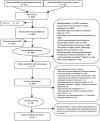Scoping review on vector-borne diseases in urban areas: transmission dynamics, vectorial capacity and co-infection
- PMID: 30173661
- PMCID: PMC6120094
- DOI: 10.1186/s40249-018-0475-7
Scoping review on vector-borne diseases in urban areas: transmission dynamics, vectorial capacity and co-infection
Abstract
Background: Transmission dynamics, vectorial capacity, and co-infections have substantial impacts on vector-borne diseases (VBDs) affecting urban and suburban populations. Reviewing key factors can provide insight into priority research areas and offer suggestions for potential interventions.
Main body: Through a scoping review, we identify knowledge gaps on transmission dynamics, vectorial capacity, and co-infections regarding VBDs in urban areas. Peer-reviewed and grey literature published between 2000 and 2016 was searched. We screened abstracts and full texts to select studies. Using an extraction grid, we retrieved general data, results, lessons learned and recommendations, future research avenues, and practice implications. We classified studies by VBD and country/continent and identified relevant knowledge gaps. Of 773 articles selected for full-text screening, 50 were included in the review: 23 based on research in the Americas, 15 in Asia, 10 in Africa, and one each in Europe and Australia. The largest body of evidence concerning VBD epidemiology in urban areas concerned dengue and malaria. Other arboviruses covered included chikungunya and West Nile virus, other parasitic diseases such as leishmaniasis and trypanosomiasis, and bacterial rickettsiosis and plague. Most articles retrieved in our review combined transmission dynamics and vectorial capacity; only two combined transmission dynamics and co-infection. The review identified significant knowledge gaps on the role of asymptomatic individuals, the effects of co-infection and other host factors, and the impacts of climatic, environmental, and socioeconomic factors on VBD transmission in urban areas. Limitations included the trade-off from narrowing the search strategy (missing out on classical modelling studies), a lack of studies on co-infections, most studies being only descriptive, and few offering concrete public health recommendations. More research is needed on transmission risk in homes and workplaces, given increasingly dynamic and mobile populations. The lack of studies on co-infection hampers monitoring of infections transmitted by the same vector.
Conclusions: Strengthening VBD surveillance and control, particularly in asymptomatic cases and mobile populations, as well as using early warning tools to predict increasing transmission, were key strategies identified for public health policy and practice.
Keywords: Arboviruses; Coinfection; Disease vectors; Epidemiology; Review; Urban population.
Conflict of interest statement
Ethics approval and consent to participate
The study protocol was approved by the University of Montreal Human Research Ethics Committee.
Consent for publication
Not applicable.
Competing interests
The authors declare that they have no competing interests.
Figures




Similar articles
-
Effective surveillance systems for vector-borne diseases in urban settings and translation of the data into action: a scoping review.Infect Dis Poverty. 2018 Sep 3;7(1):99. doi: 10.1186/s40249-018-0473-9. Infect Dis Poverty. 2018. PMID: 30217142 Free PMC article.
-
Impact, economic evaluation, and sustainability of integrated vector management in urban settings to prevent vector-borne diseases: a scoping review.Infect Dis Poverty. 2018 Sep 3;7(1):83. doi: 10.1186/s40249-018-0464-x. Infect Dis Poverty. 2018. PMID: 30173675 Free PMC article.
-
Arbovirus vectors of epidemiological concern in the Americas: A scoping review of entomological studies on Zika, dengue and chikungunya virus vectors.PLoS One. 2020 Feb 6;15(2):e0220753. doi: 10.1371/journal.pone.0220753. eCollection 2020. PLoS One. 2020. PMID: 32027652 Free PMC article.
-
[Impact of changes in the environment on vector-transmitted diseases].Sante. 1997 Jul-Aug;7(4):263-9. Sante. 1997. PMID: 9410453 Review. French.
-
Beyond the black stump: rapid reviews of health research issues affecting regional, rural and remote Australia.Med J Aust. 2020 Dec;213 Suppl 11:S3-S32.e1. doi: 10.5694/mja2.50881. Med J Aust. 2020. PMID: 33314144
Cited by
-
Zika virus infection and microcephaly: spatial analysis and socio-environmental determinants in a region of high Aedes aegypti infestation in the Central-West Region of Brazil.BMC Infect Dis. 2021 Oct 27;21(1):1107. doi: 10.1186/s12879-021-06805-1. BMC Infect Dis. 2021. PMID: 34706662 Free PMC article.
-
Epidemiological study on dengue in southern Brazil under the perspective of climate and poverty.Sci Rep. 2020 Feb 7;10(1):2127. doi: 10.1038/s41598-020-58542-1. Sci Rep. 2020. PMID: 32034173 Free PMC article.
-
Arboviral diseases and COVID-19 coincidence: Challenges for Pakistan's derelict healthcare system.J Med Virol. 2021 Dec;93(12):6465-6467. doi: 10.1002/jmv.27241. Epub 2021 Aug 7. J Med Virol. 2021. PMID: 34324213 Free PMC article. No abstract available.
-
Clinical Cases of Tick-Borne Diseases in Dogs During the Autumn-Winter Season in Poland.Pathogens. 2024 Dec 21;13(12):1132. doi: 10.3390/pathogens13121132. Pathogens. 2024. PMID: 39770391 Free PMC article.
-
Teaching inequity in vector-borne diseases management through a socioscientific issue framework.One Health. 2025 Mar 25;20:101019. doi: 10.1016/j.onehlt.2025.101019. eCollection 2025 Jun. One Health. 2025. PMID: 40230585 Free PMC article.
References
-
- World Health Organization. Vector-borne diseases [Internet]. 2016 [cited 2017 Aug 17]. Available from: http://www.who.int/en/news-room/fact-sheets/detail/vector-borne-diseases.
-
- Anderson R, May R. Infectious diseases of humans: Oxford Science Publications; 1991.
-
- World Health Organization. World Malaria Report. Geneva. 2016:2016.
Publication types
MeSH terms
LinkOut - more resources
Full Text Sources
Other Literature Sources
Medical

